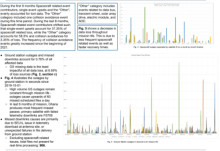Quantifying Sources of Data Loss for the FORMOSAT-7/COSMIC-2 Mission
Gavin C.
James
University Corporation for Atmospheric Research (UCAR)
Poster
The FORMOSAT-7/COSMIC-2 (F7C2) mission has a system operational availability requirement of greater than or equal to 91.5% from Full Operational Capability (FOC) to the end of mission duration. In this analysis we identify the primary sources of data loss for F7C2 as the mission approaches FOC. Four specific sources of data loss are considered: 1) loss attributed to spacecraft outage, such as single-event upsets (SEUs) leading to unplanned safe modes, 2) loss attributed to ground station issues that result in the failure of data either being downloaded from the spacecraft or sent to the US Data Processing Center (USDPC) for real-time processing, 3) payload anomalies resulting in loss of instrument data, and 4) loss attributed to data processing center outage such as errors in the processing algorithms within the COSMIC Data Analysis and Archive Center (CDAAC) located at UCAR. Analysis has shown a significant decrease in data loss from mission start compared to the last 6 months of operations. Throughout all phases of mission life, the largest contributor to data loss has been spacecraft-related events. While total loss has decreased over time, the proportion of contribution from each source has remained constant.
This presentation summarizes the methods that have been developed within the USDPC to quantify data loss for each of the four segments of this analysis. All of the above stated data loss sources and future RO missions can benefit from the lessons learned by developing more autonomous ways of validating data management requirements and minimizing loss. We summarize the implications of the loss to the overall mission status and discuss configuration of these tools within CDAAC architecture for the near future. When data loss related to spacecraft lowering is excluded, the F7C2 mission has provided greater than 91.5% data availability.
This presentation summarizes the methods that have been developed within the USDPC to quantify data loss for each of the four segments of this analysis. All of the above stated data loss sources and future RO missions can benefit from the lessons learned by developing more autonomous ways of validating data management requirements and minimizing loss. We summarize the implications of the loss to the overall mission status and discuss configuration of these tools within CDAAC architecture for the near future. When data loss related to spacecraft lowering is excluded, the F7C2 mission has provided greater than 91.5% data availability.

Poster PDF